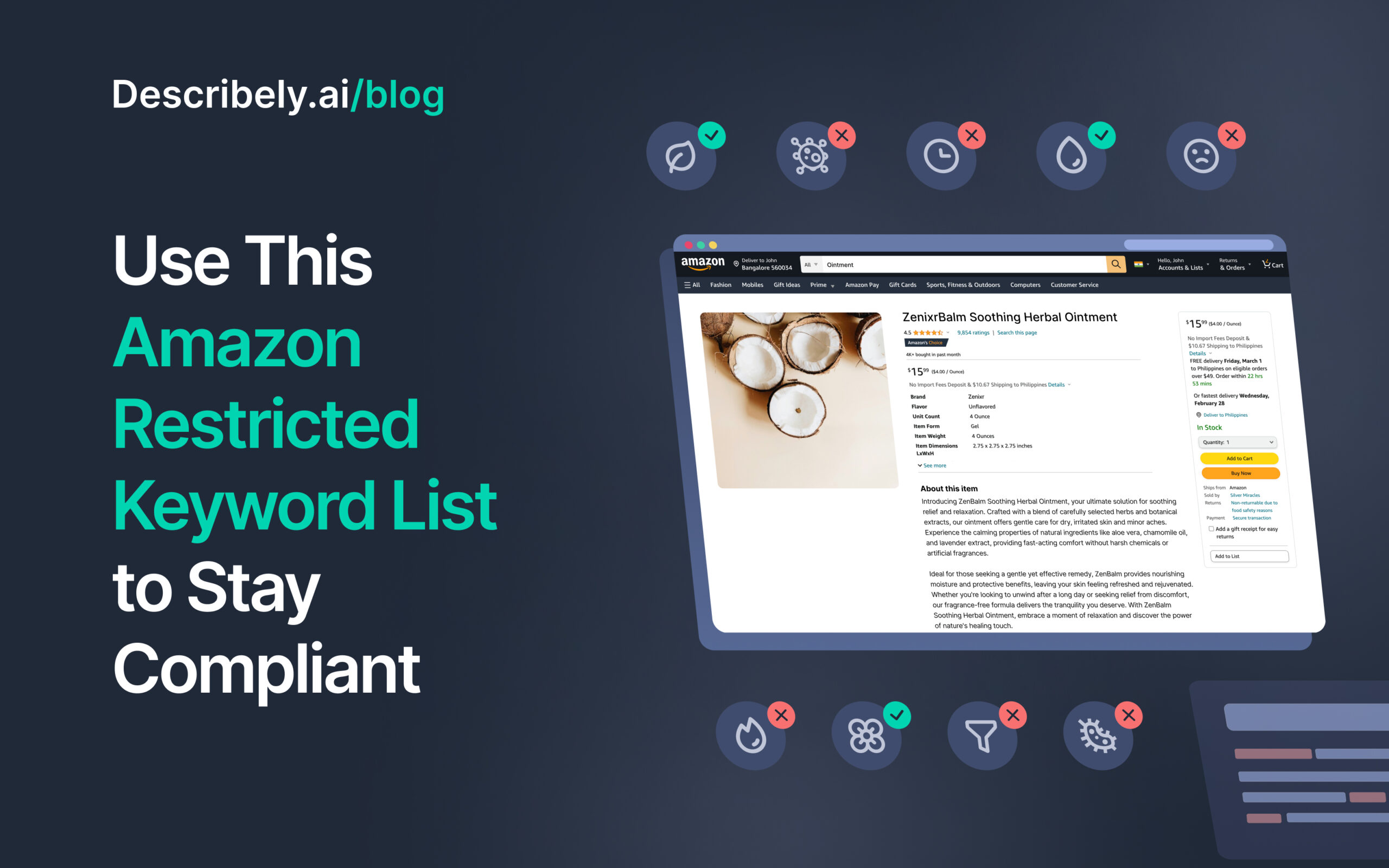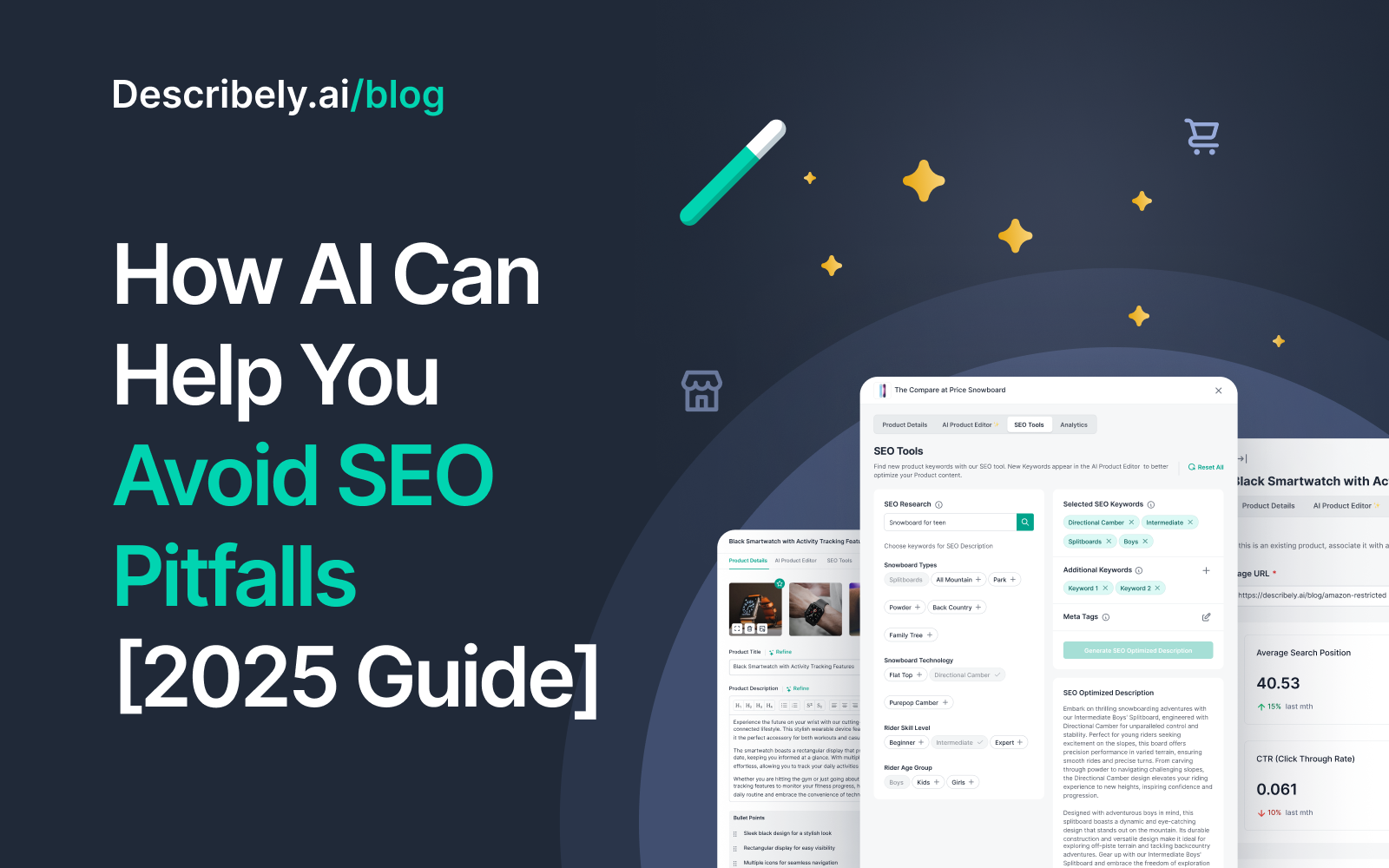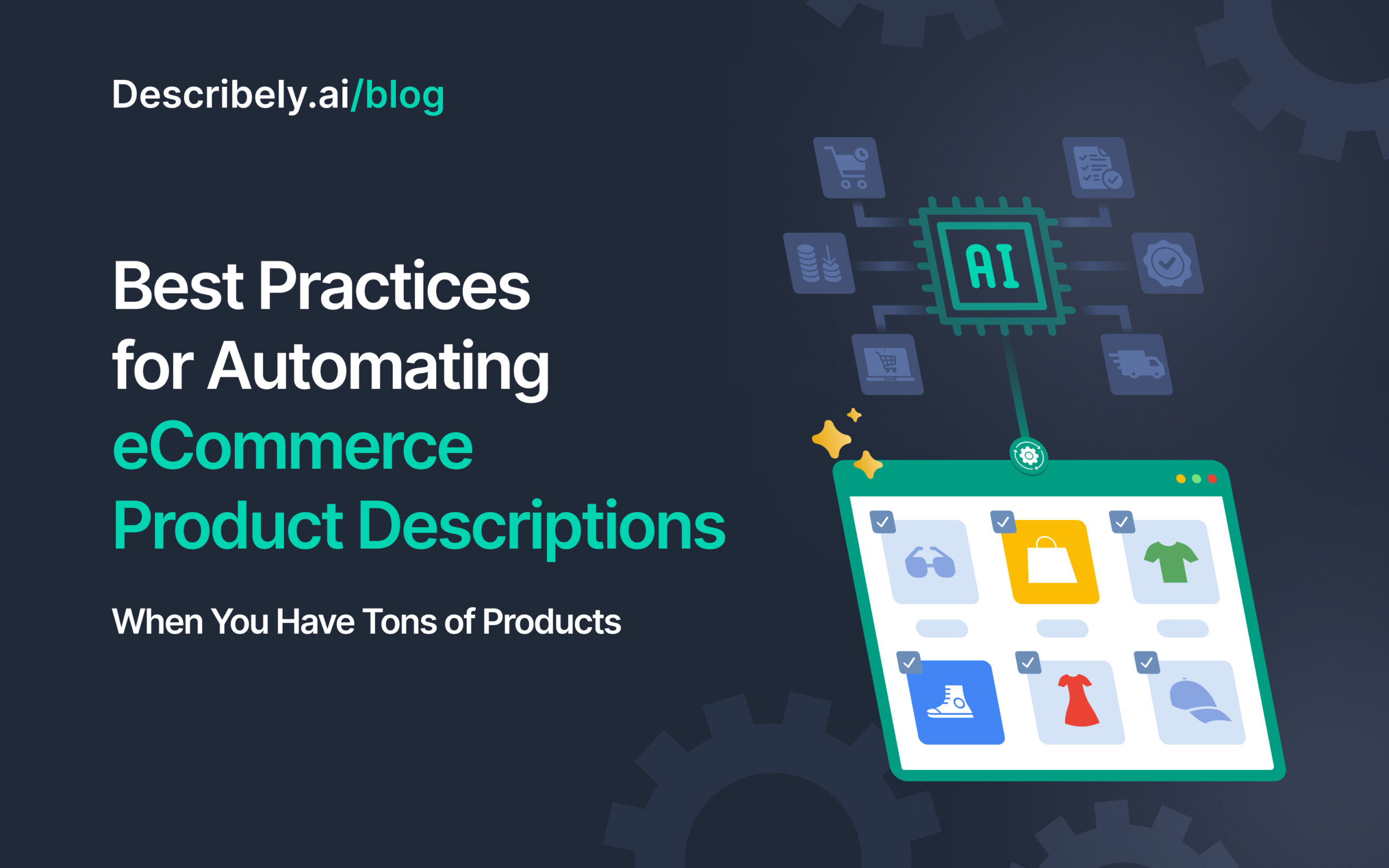
Best Practices for Automating eCommerce Product Descriptions When You Have Tons of Products
We might be in the golden age of AI, but let’s be honest with ourselves—the idea of leveraging AI to create product descriptions is still a novel idea for many eCommerce businesses.
And there’s some validity in all the hesitations they have about using AI, too. After all, who’s to say that the quality of these descriptions would remain consistent and convert customers just the same?
Integrating AI tools in existing workflows can really be an experiment, and many eCommerce content teams are not ready to be the first ones to take on this task of trial-and-error.
We get where you’re coming from, but thankfully, there’s reason to end the indecisiveness about AI’s effectiveness, as other eCommerce content managers and writers have already undertaken this experiment and have (great!) results to share.
In fact, as it turns out, using AI for automating product descriptions is more normalized than you might realize. Data suggests that 1 in 4 marketers use AI to create product content, and even larger brands like Alibaba, Target, and Matalan have started using AI to create product content.
And there’s a benefit in this practice, too—as it so happens, businesses that used AI for product descriptions saw a 30% increase in conversion rates.
So, if you wish to replicate these results for your eCommerce businesses too and are ready to leverage AI in your product content journey, here’s a complete guide on all the best practices you should consider.
Alternatively, if you’re ready to use AI tools that can produce top-notch product descriptions for you, you know where to get started: Sign up for Describely now!
What is an auto-generated product description?
Just so that we’re on the same page, here’s how we’d describe automated product descriptions: It’s basically the process of using generative AI tools (like Describely) to produce product content. Typically, you might need to provide the AI tool with some context about your product.
For example, here’s what a text description automatically generated in Describely looks like:
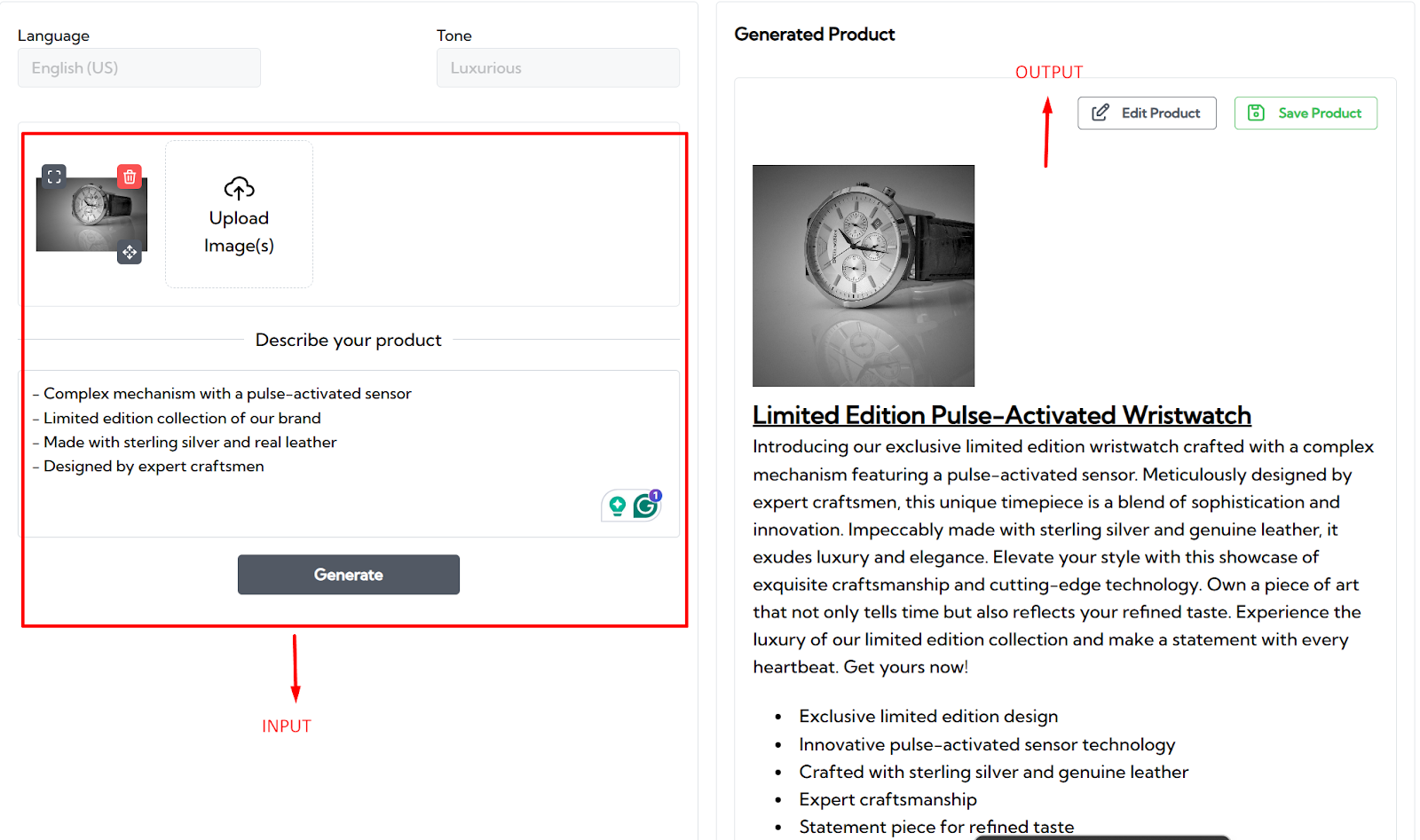
Best practices for automating product descriptions with AI
Here are some of the best practices you should consider when using AI tools for automated product content creation.
1. Ensure the AI-generated product descriptions align with brand voice and style guidelines
First thing first, to ensure your product descriptions look authentic and “on brand,” you’ll need to provide AI tools with context about what your brand voice and content style guide look like.
On the flip side, if AI tools don’t have any reference pointers on how they should design product content, they will often:
- Go on and on about product benefits (making your content read more like a blog and less like a description); and/or
- Create product content that’s virtually no different than everything else on the internet.
Worse yet, in some cases, your customers might also be able to point out which descriptions were written by AI if some of them don’t match the same tone/brand guidelines as your other product content.
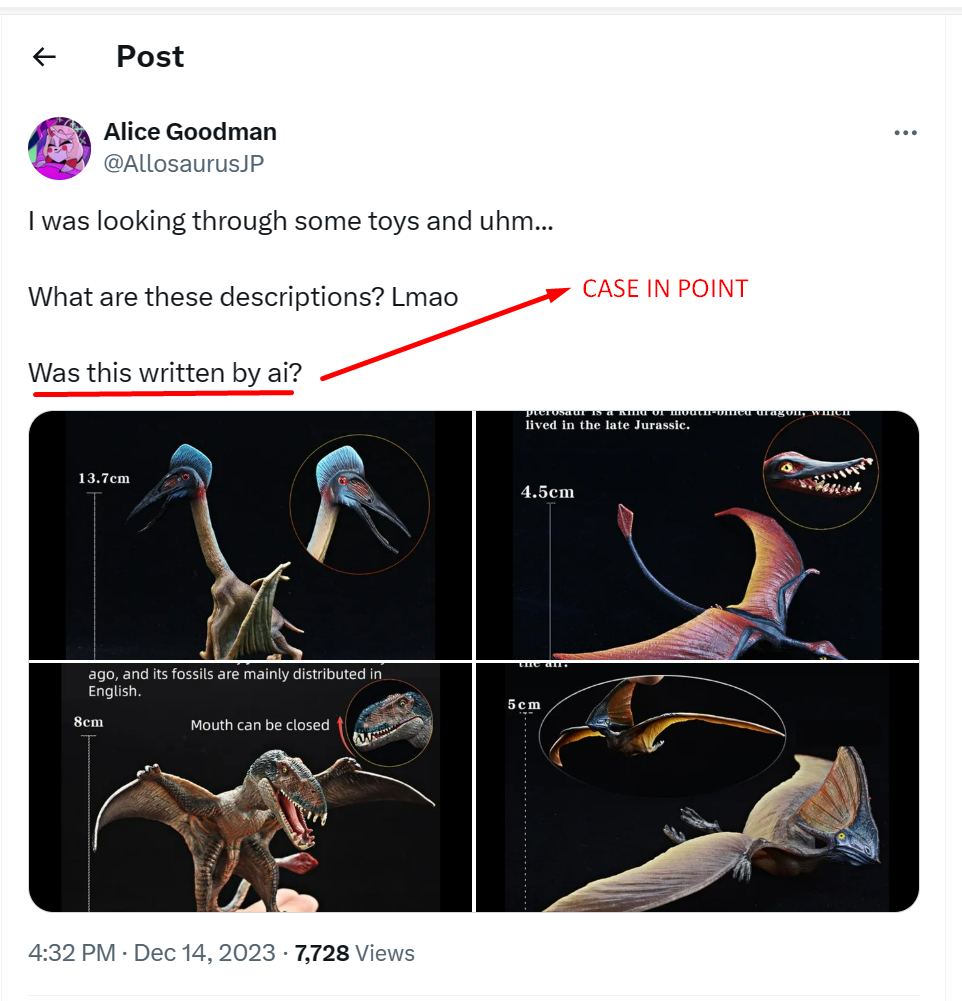
So, to avoid scenarios like these, it’s always best to train AI about your brand content requirements.
We subscribe to this practice by allowing our users to customize AI Rulesets to ensure they get the best of both worlds (aka, the efficiency of an AI tool and adherence to style guide requirements).
Just for reference, here’s what an AI ruleset in Describely looks like:
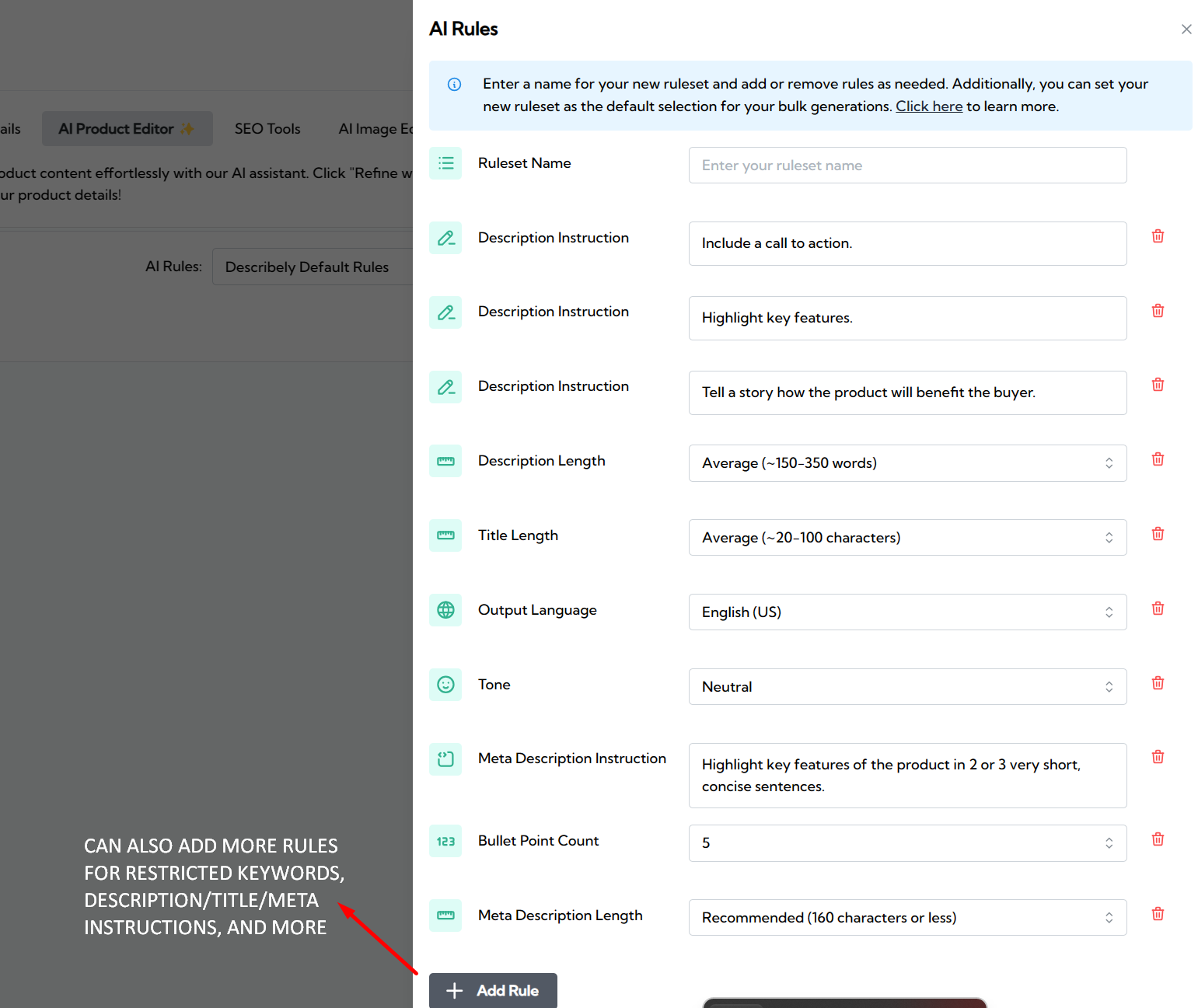
2. Hire a human to monitor and adjust the AI product descriptions to avoid repetitive or generic content
Since a majority of AI tools are trained on existing data, they also run into the risk of churning out content that’s all too repetitive and generic.
This is why it makes sense to hire human writers and editors who can refine the content output of these AI tools and add a touch of creativity to your descriptions. The experts agree with us on this, too.
Our in-house customer experience manager, Kyle, said:
“Think of any AI tool as your partner, not your replacement—it performs best when you’re driving it.”
Jess, Describely’s CX specialist, agreed by adding,
“Recognize that you will most likely need to review your content before going live, so minimizing edits will save you time in the long run.”
In fact, eCommerce brands like IrresistibleMe are actively practicing this approach and say their content stands out because of the blend of AI speed and a sprinkle of human creativity.
We contacted the IrresistibleMe team for a quote, and Kate Ross, their PR specialist, said,
“It’s about making sure our product content is done in a way that feels right to both us and our customers. Even though AI can write product descriptions, we (leverage this practice to) ensure it still sounds like us, so our customers feel like they’re talking to us and not a robot.”
3. Check and recheck if the product descriptions are accurate and provide relevant information about the products
Accuracy is another big thing with AI. If your product descriptions are not accurate, it might lead to reputation-damaging situations like these:
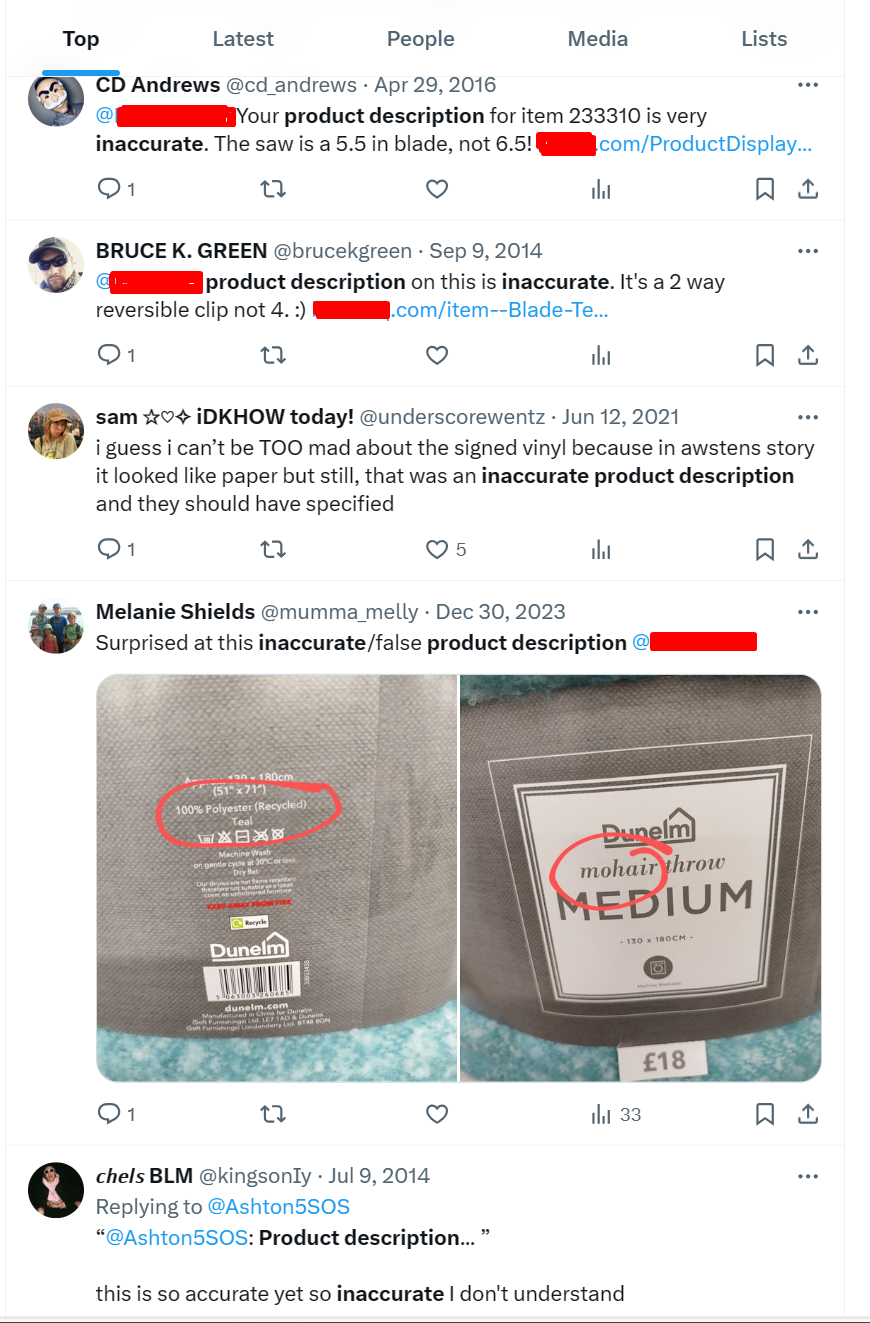
If customers call you out on such an issue too many times, it might also lead to a decrease in brand goodwill and trust.
So, to avoid circumstances like these, always triple-check that your descriptions are accurate and provide all the relevant information about the product.
Because here’s the thing—if the product data that you’re feeding the AI isn’t accurate, then your descriptions won’t be accurate either.
Having said this, we also realize that it’s often difficult to find all of your product attributes, especially when dealing with hundreds to thousands of products at once. For such situations, you can leverage Describely’s data enrichment feature to explore unique angles.
With Describely, this means you can select the products from the catalog you want to enrich, verify which fields you’d like to use in search, and supply the tool with the manufacturer’s website so it can find the correct product attributes (this is optional but highly recommended).
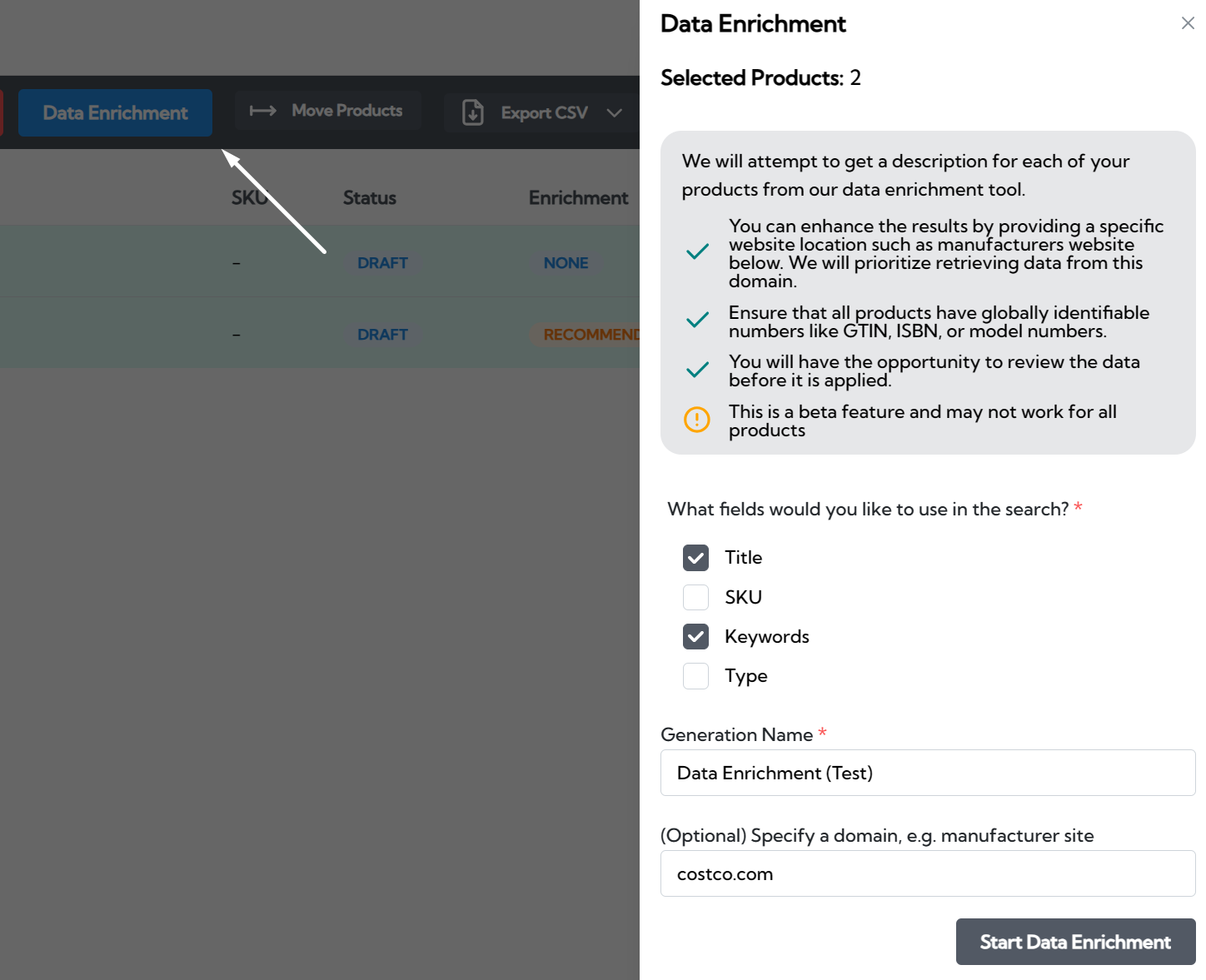
4. Ensure the AI-generated product descriptions are optimized for SEO and will help drive traffic to your eCommerce website
According to a 2023 study, almost 8 in 10 bloggers and SEO pros agree that AI has assisted them with their SEO strategy. This comes as no surprise considering the use cases of AI when it comes to SEO, namely:
- Being able to do keyword research
- Integrating keywords seamlessly
- Creating content for on-page elements (like alt texts and meta content)
- Analyzing content strength and performance
However, when we look at product descriptions alone, AI-enabled SEO optimization will allow your product descriptions to become easily findable, provide you with a competitive advantage, improve user experience, and potentially increase ROI.
Considering all these benefits, Describely has SEO optimization features, too. Just for reference, here are all the SEO-related capabilities our tool offers:
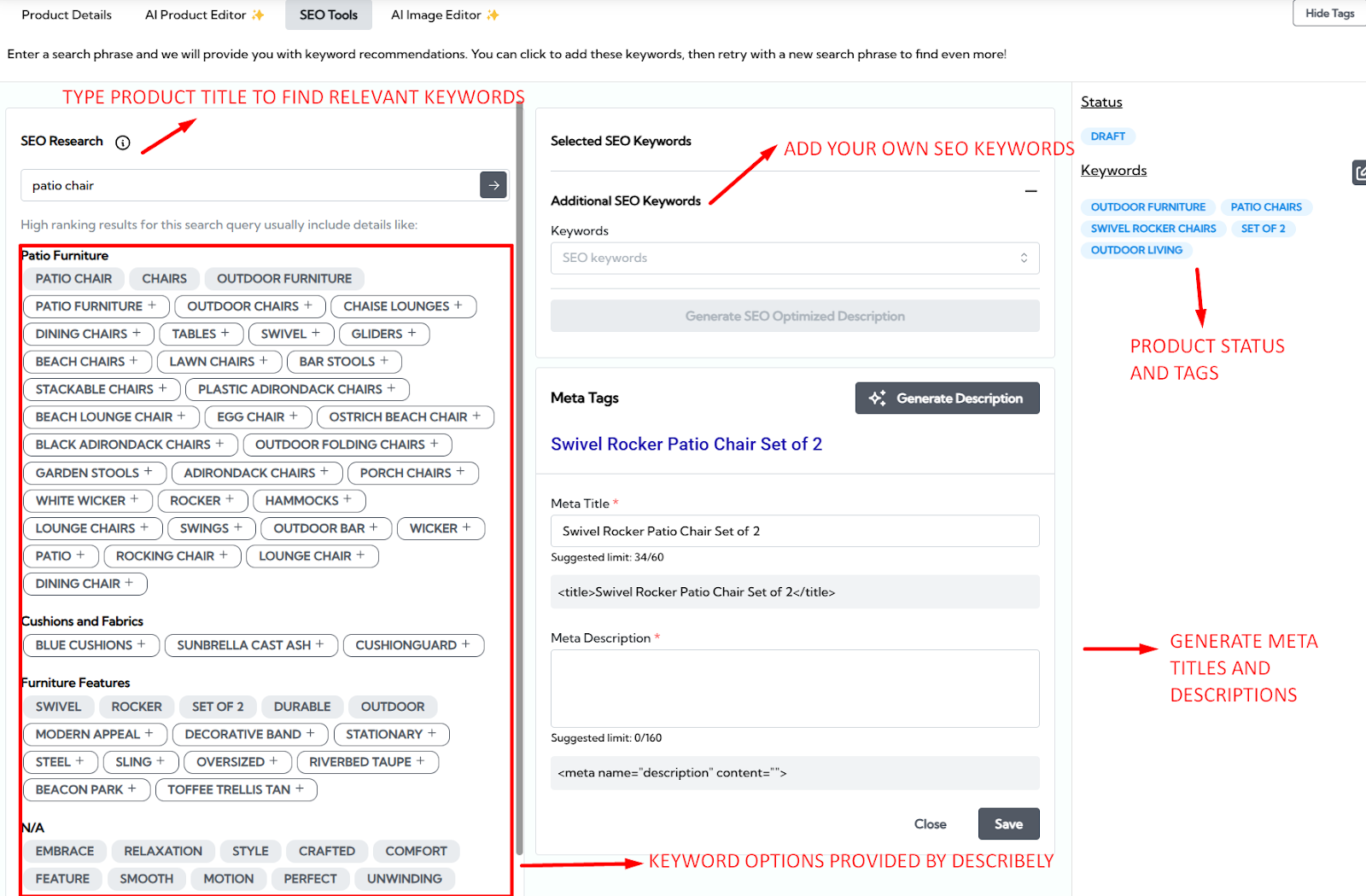
5. Track the use of negative keywords in the AI product descriptions
Here’s the thing: eCommerce platforms (like Amazon and the likes) have a list of restricted keywords—-if you use these keywords in your product copies, the chances of your listing getting banned or penalized skyrocket.
Alternatively, you, too, might have a list of negative keywords you would want to avoid. For example, using competitor names in product descriptions would be a no-go for many businesses.
So, here’s another best practice when it comes to creating automated product descriptions: Always feed your AI tools a negative keyword list so they can produce content that requires minimal edits.
For example, in generic tools like ChatGPT, you can feed a prompt like this for each product (please note that each product will require its own prompt to ensure ChatGPT produces content that’s compliant with your request):

However, eCommerce-focused tools like Describely will already have a copy of the Amazon restricted keyword and will also allow you to create a negative keyword list of your own, too.
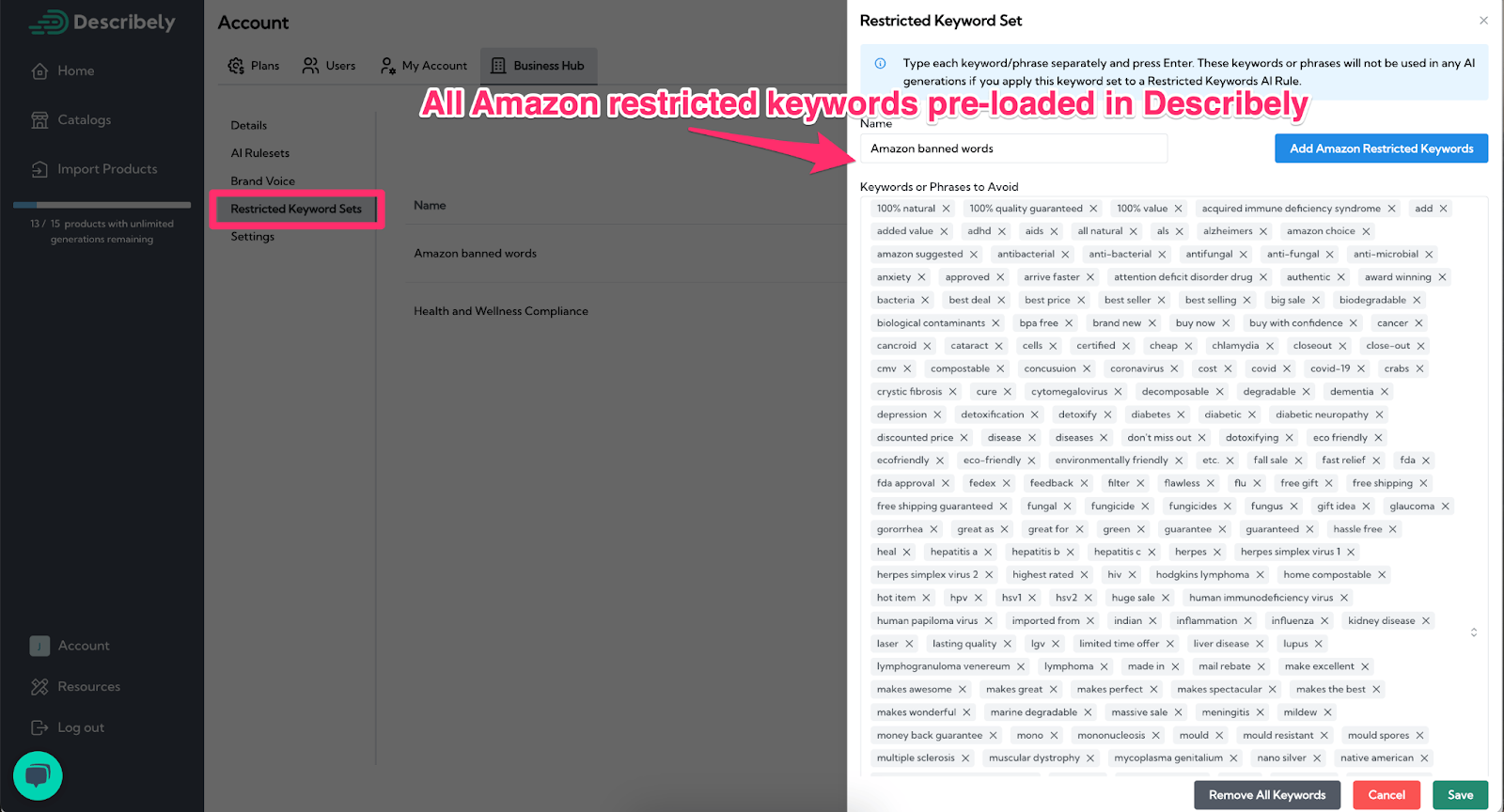
[Side Note: For inspiration about which negative keywords to avoid, you can grab a copy of Describely’s exclusive negative keyword list. This list covers keywords that might create issues on storefronts like Amazon, result in high bounce rates, or cause compliance concerns.]
6. Keep things short and sweet — don’t let the AI rant on and on about your products
Just for a quick visual experiment, let’s compare two automated product descriptions.
Here’s one from Describely:
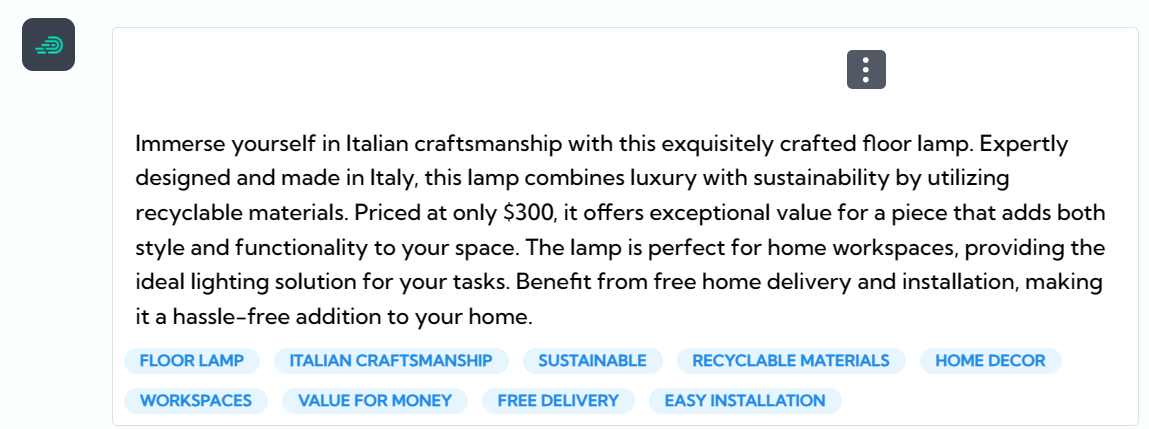
And the other one’s from ChatGPT:
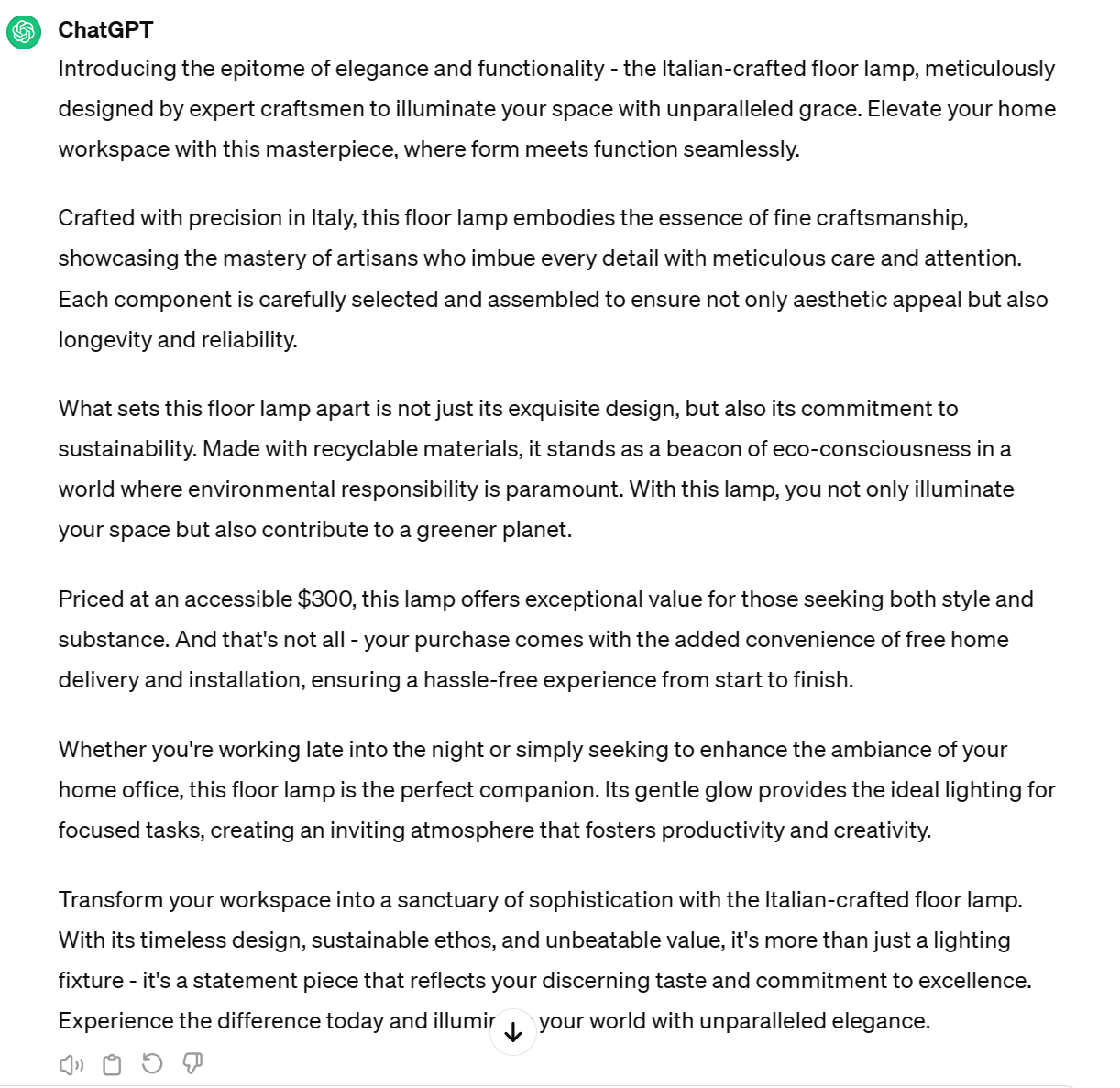
Now, just to compare things visually—which product description are you more likely to read?
We asked a few friends the same question (to avoid our own biases), and they went with the former answer (aka the shorter description), mainly because both descriptions offer the same value when it comes to actual information (both have information about pricing, origin of craftsmanship, details about shipping/installation, and quality of materials).
However, simply because Describely’s description was shorter than ChatGPT’s and hence required lesser cognitive load, it was easier for them to read.
Your customers might have the same experience, too, which is why we’d recommend training your AI tool and asking it to produce shorter descriptions that require less cognitive load.
On that note, this might be the perfect time to mention that in Describely, you can set rules about how long or short you want your descriptions and titles to be.
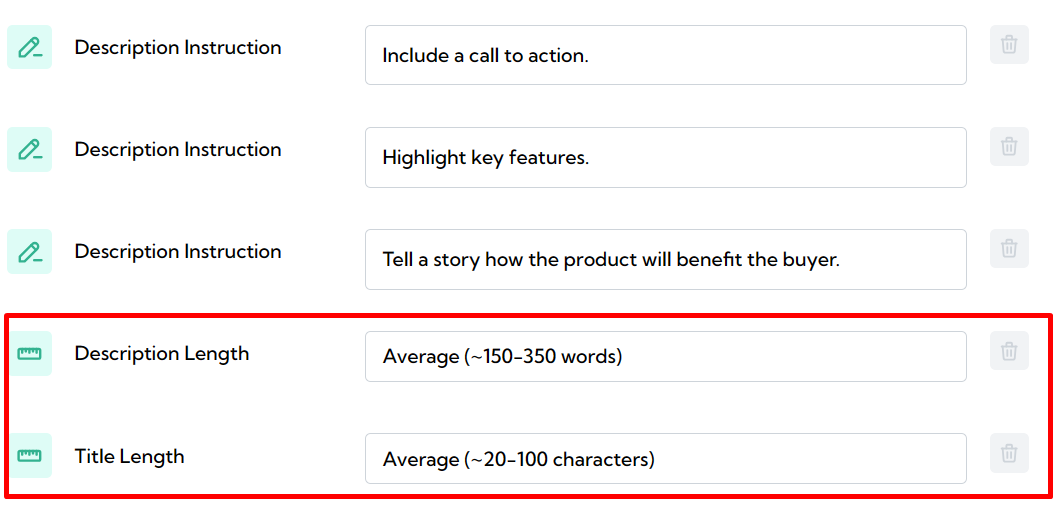
7. Highlight the product’s unique selling points in the AI’s backend
Highlighting the product’s USP is a win-win situation for both parties: It shows customers what differentiates you from your competitors, and in turn, it results in more sales for you.
In AI tools like Describely, you get the option to mention product USPs through bullet points (or the tool can extract product data from the image provided as well).
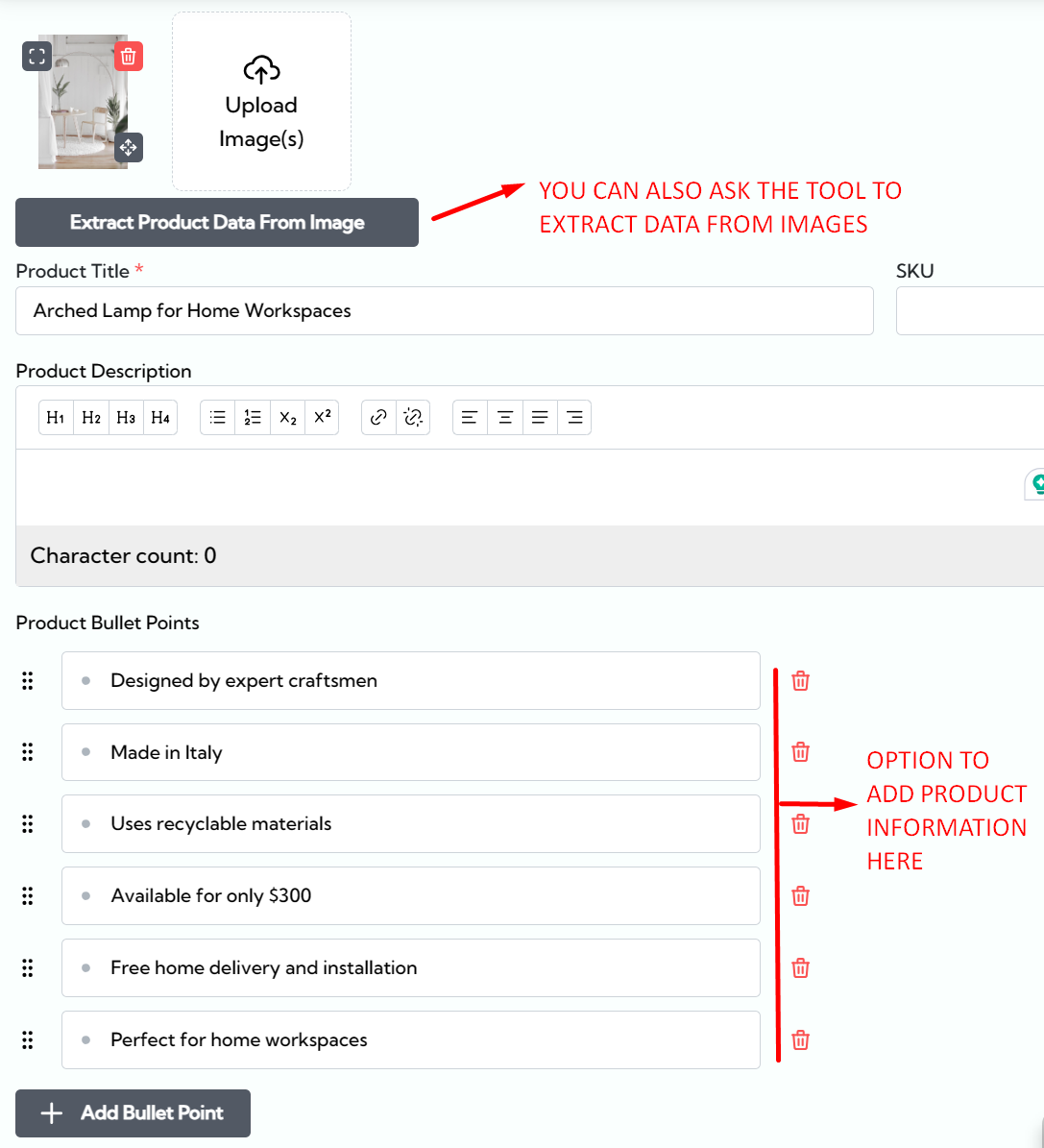
We often recommend our customers to use this option as liberally as possible to ensure your product descriptions have a lot of valuable information as opposed to fluff that adds no meaning.
In certain situations, this also means providing AI with context about customer intent and the product attributes they’d like to learn about.
8. Consider other aspects like diversity, legality, and customer experience when reviewing and publishing AI-generated product descriptions
Lastly, here’s one best practice that every eCommerce company should consider, regardless if they use AI to produce product descriptions or not: Always consider crucial aspects like diversity, legality, and customer experience before hitting the “publish” button on your product descriptions.
However, as it so happens, since AI doesn’t have any sense of human interaction, it does not consider these aspects more so than humans, so it’s always best to refine and edit the results AI tools generate to ensure you’re consciously considering these aspects.
For example, if you’re writing a product description for a dress, consider how the dress would look and feel on different body types.
Just as a reference, brands like Target are making an effort to write about the product’s size and model’s height so customers know what the product would look like based on their body size(s) and height(s).
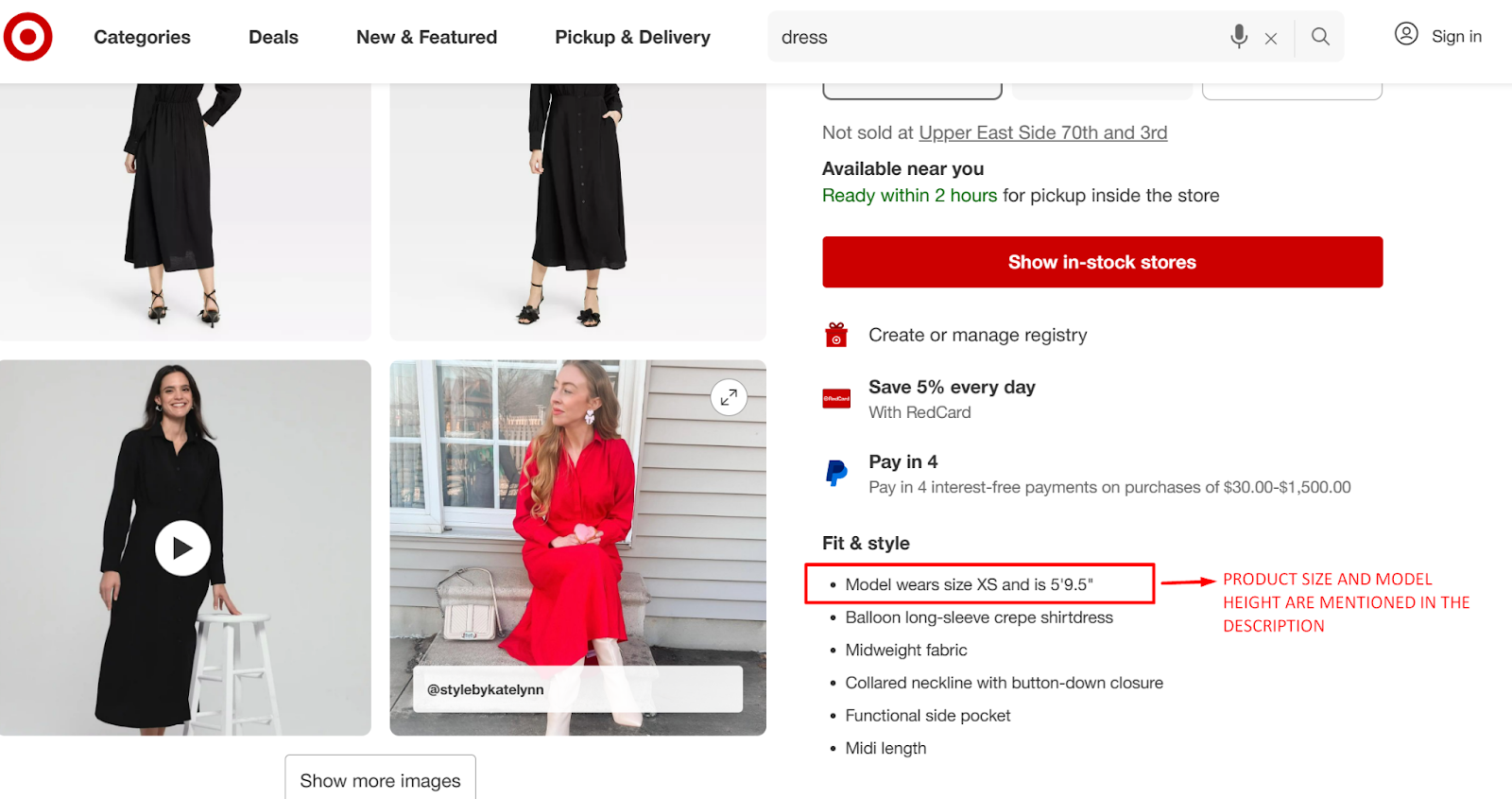
As far as other aspects are concerned, like legality and customer experience, here’s what our in-house experts have to say:
Legality: “There are several niche categories (think about food & the health space) where certain buzzwords should mean a lot but lose their significance when overused or used incorrectly,” says Kyle. In certain situations, misinformation about your product details can also result in a legal case of false advertisement or product misrepresentation.
CX: Kayla, in an interview with Wade Cline from TrustSpot.io, recommended the following best practices:
- Addressing potential buyer questions;
- Crafting product descriptions that resonate with the reader; and
- Thinking in the shoes of the shopper.
You can access her full interview here to learn more best practices for enhancing customers’ experience with your product pages.
Describely: The best tool for automated product content creation?
If you’ve read this far, there’s a good chance you’re planning on using an AI tool for automating product content creation (or you already use one and want to improve its efficiency).
And if you’ve stuck around till here, you might also know some of the features Describely offers, such as:
- Being able to automatically generate (and update) product descriptions
- Optimizing content with keywords and other SEO best practices
- Creating custom AI rulesets
- Delivering product content that considers content length (as well as highlights the things that add value to the reader’s lives)
- Having a negative keyword feature
- And so much more!
So, if you think Describely can help you create automated product descriptions, get started now!


